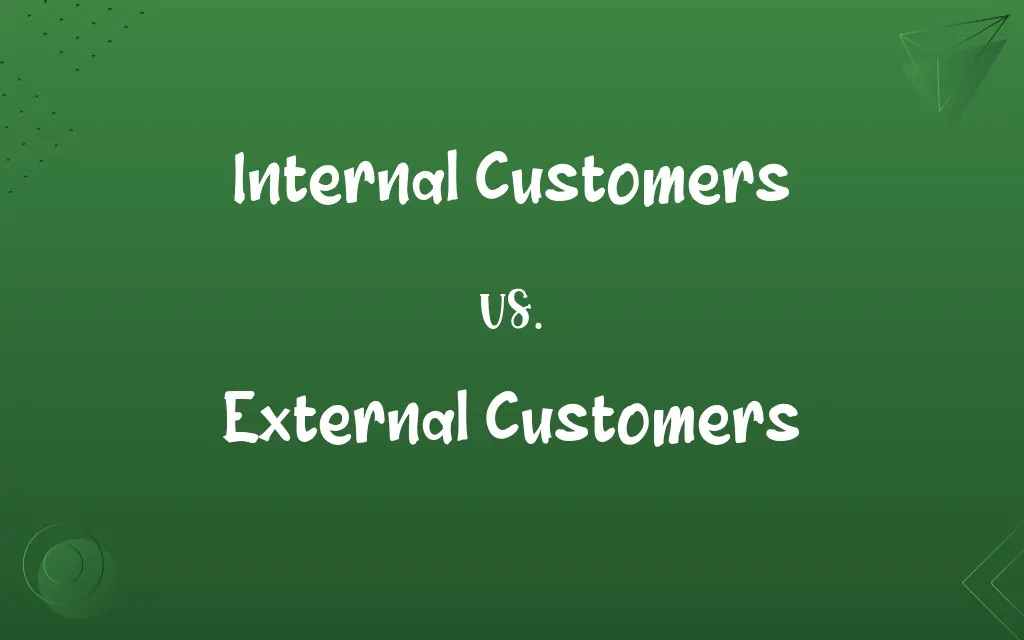Internal Customers vs. External Customers: Know the Difference

By Shumaila Saeed || Updated on December 25, 2023
Internal Customers are employees or departments within a company who use its services, while External Customers are individuals or entities outside the company who purchase its products or services.

Key Differences
Internal Customers refer to individuals or departments within an organization that rely on assistance or services from another part of the same organization. For example, a marketing department may be an internal customer of the IT department. External Customers, on the other hand, are those who are not part of the organization but engage with it by purchasing goods or services. These can include individual consumers or other businesses.
Shumaila Saeed
Nov 16, 2023
The needs of Internal Customers are often focused on supporting their ability to perform their duties within the organization. Their satisfaction can directly affect the company's efficiency and workplace morale. External Customers, however, are primarily concerned with the value and quality of the products or services they purchase, impacting the business's revenue and reputation.
Shumaila Saeed
Nov 16, 2023
Internal Customers are integral to the company’s processes and workflows, and their feedback is crucial for internal improvements and innovation. In contrast, External Customers provide valuable insights into market trends, customer satisfaction, and areas for product or service enhancement.
Shumaila Saeed
Nov 16, 2023
The relationship with Internal Customers is continuous and built around ongoing support and collaboration. For External Customers, the relationship is transactional, often centered around specific purchases or contracts.
Shumaila Saeed
Nov 16, 2023
In terms of prioritization, Internal Customers can sometimes be overlooked in favor of External Customers, but balancing the needs of both is crucial for long-term organizational success. While External Customers drive revenue, Internal Customers drive the company's operations and culture.
Shumaila Saeed
Nov 16, 2023
ADVERTISEMENT
Comparison Chart
Impact
Affect company efficiency and morale
Influence revenue and market reputation
Shumaila Saeed
Nov 16, 2023
Feedback
Focuses on internal improvements
Guides product/service enhancements
Shumaila Saeed
Nov 16, 2023
Engagement Type
Continuous, within organizational processes
Specific, often linked to purchases
Shumaila Saeed
Nov 16, 2023
Prioritization
Essential for operational excellence
Crucial for financial success
Shumaila Saeed
Nov 16, 2023
ADVERTISEMENT
Internal Customers and External Customers Definitions
Internal Customers
Employees or units within a company that depend on resources or services from another internal segment.
The HR department serving as Internal Customers to the IT department for software solutions.
Shumaila Saeed
Nov 10, 2023
External Customers
The end-users or consumers of a company's goods or services.
A person using a banking app is an External Customer of the bank.
Shumaila Saeed
Nov 10, 2023
Internal Customers
Internal entities that require support or services for organizational functions.
The legal department is an Internal Customer to the administrative team for document processing.
Shumaila Saeed
Nov 10, 2023
External Customers
External parties that influence a company's market presence and revenue through purchases.
Tourists visiting a theme park are External Customers of the park.
Shumaila Saeed
Nov 10, 2023
Internal Customers
Internal stakeholders who receive and utilize outputs from other parts of the same organization.
Sales teams are Internal Customers of market research data from the analytics team.
Shumaila Saeed
Nov 10, 2023
ADVERTISEMENT
External Customers
Individuals or organizations outside a company that purchase or use its products or services.
A family buying furniture from a retailer represents External Customers.
Shumaila Saeed
Nov 10, 2023
Internal Customers
Members of an organization who are recipients of services from their colleagues or departments.
The finance team acting as Internal Customers to the procurement department for budget reports.
Shumaila Saeed
Nov 10, 2023
External Customers
Clients or consumers outside the organization's internal structure.
Patients receiving treatment at a hospital are External Customers of the hospital.
Shumaila Saeed
Nov 10, 2023
Internal Customers
Organizational segments that rely on intra-company interactions to fulfill their roles.
The customer service team is an Internal Customer to the product development team for feedback.
Shumaila Saeed
Nov 10, 2023
External Customers
Non-employee stakeholders who engage in transactions with a business.
A business contracting a software company for services is an External Customer.
Shumaila Saeed
Nov 10, 2023
Repeatedly Asked Queries
Why are External Customers important?
They drive revenue and influence market reputation.
Shumaila Saeed
Nov 16, 2023
What is an example of an External Customer?
An individual purchasing clothes from a retail store.
Shumaila Saeed
Nov 16, 2023
How do Internal Customers affect a business?
They impact operational efficiency and internal workflow.
Shumaila Saeed
Nov 16, 2023
Who are Internal Customers?
Employees or departments within a company relying on other internal services or products.
Shumaila Saeed
Nov 16, 2023
Can an employee be both an Internal and External Customer?
Yes, when they use internal services and also purchase the company’s products.
Shumaila Saeed
Nov 16, 2023
How do businesses meet the needs of External Customers?
By offering quality products/services and excellent customer service.
Shumaila Saeed
Nov 16, 2023
Are Internal Customers always employees?
Primarily, but they can also include internal stakeholder groups.
Shumaila Saeed
Nov 16, 2023
How does feedback from Internal Customers differ from External Customers?
Internal feedback focuses on improving internal processes, while external feedback addresses market needs.
Shumaila Saeed
Nov 16, 2023
Why is balancing Internal and External Customers important?
It ensures both operational excellence and market success.
Shumaila Saeed
Nov 16, 2023
What's a key difference in managing Internal vs. External Customers?
Internal management focuses on collaboration, while external management prioritizes satisfaction and retention.
Shumaila Saeed
Nov 16, 2023
How do Internal Customers contribute to a company’s culture?
They shape the working environment and internal collaboration dynamics.
Shumaila Saeed
Nov 16, 2023
Are Internal Customers involved in decision-making?
Often, especially in matters affecting their operations or workflow.
Shumaila Saeed
Nov 16, 2023
What impact do Internal Customers have on external service quality?
A significant one, as their efficiency and morale can affect overall service delivery.
Shumaila Saeed
Nov 16, 2023
How can a company improve its relationship with Internal Customers?
Through effective communication, support, and collaboration.
Shumaila Saeed
Nov 16, 2023
Can a company's success be solely determined by External Customers?
Not entirely, as Internal Customers also play a crucial role in its functioning.
Shumaila Saeed
Nov 16, 2023
What challenges do companies face with External Customers?
Meeting diverse needs, competition, and maintaining satisfaction.
Shumaila Saeed
Nov 16, 2023
How can companies effectively engage with External Customers?
By understanding their needs, personalized communication, and after-sales support.
Shumaila Saeed
Nov 16, 2023
What role do External Customers play in product development?
Their needs and feedback guide innovation and improvements.
Shumaila Saeed
Nov 16, 2023
Can External Customer relationships impact a brand's image?
Yes, significantly through customer satisfaction and word-of-mouth.
Shumaila Saeed
Nov 16, 2023
What strategies can improve External Customer loyalty?
High-quality products, excellent customer service, and consistent brand values.
Shumaila Saeed
Nov 16, 2023
Share this page
Link for your blog / website
HTML
Link to share via messenger
About Author
Written by
Shumaila SaeedShumaila Saeed, an expert content creator with 6 years of experience, specializes in distilling complex topics into easily digestible comparisons, shining a light on the nuances that both inform and educate readers with clarity and accuracy.









































































